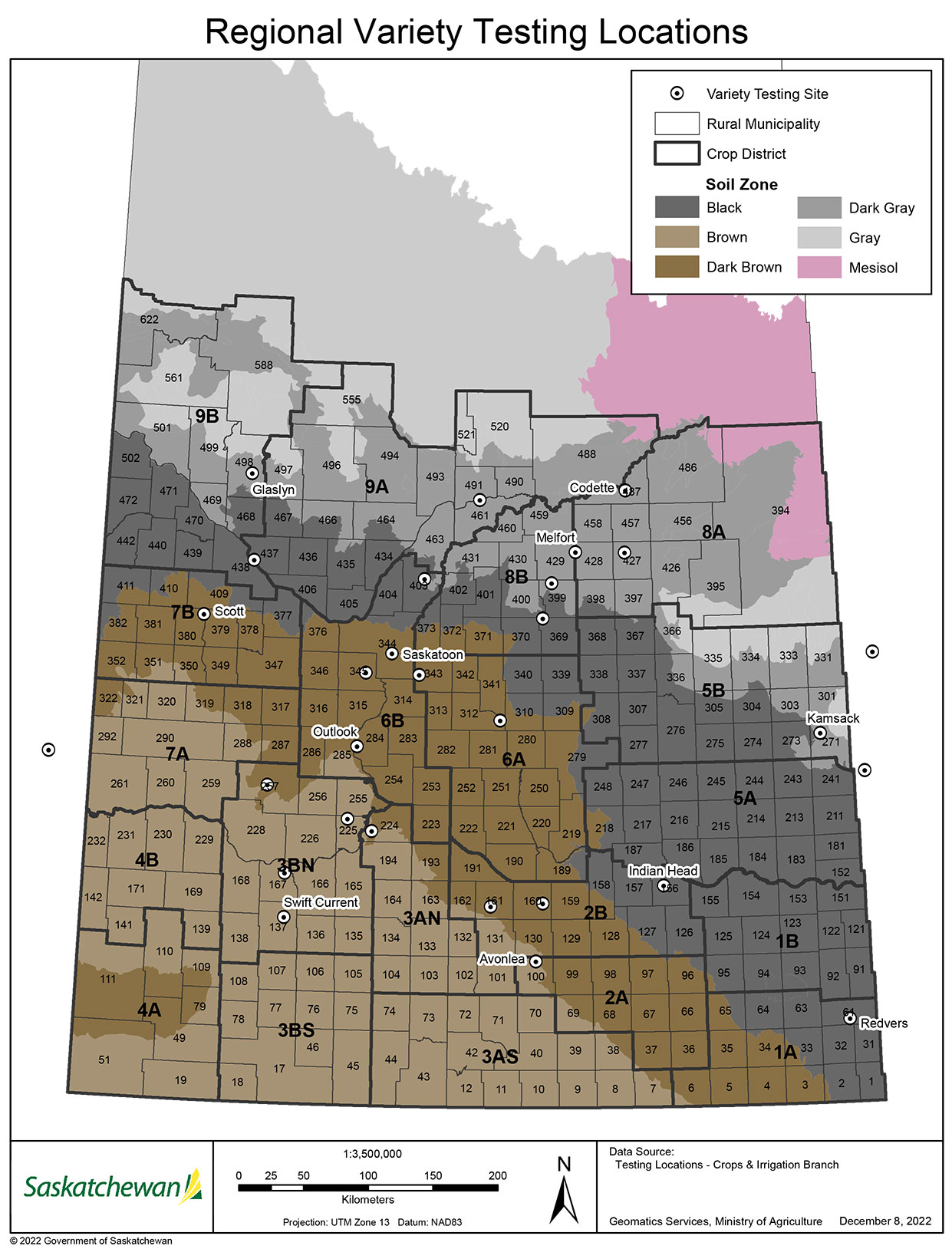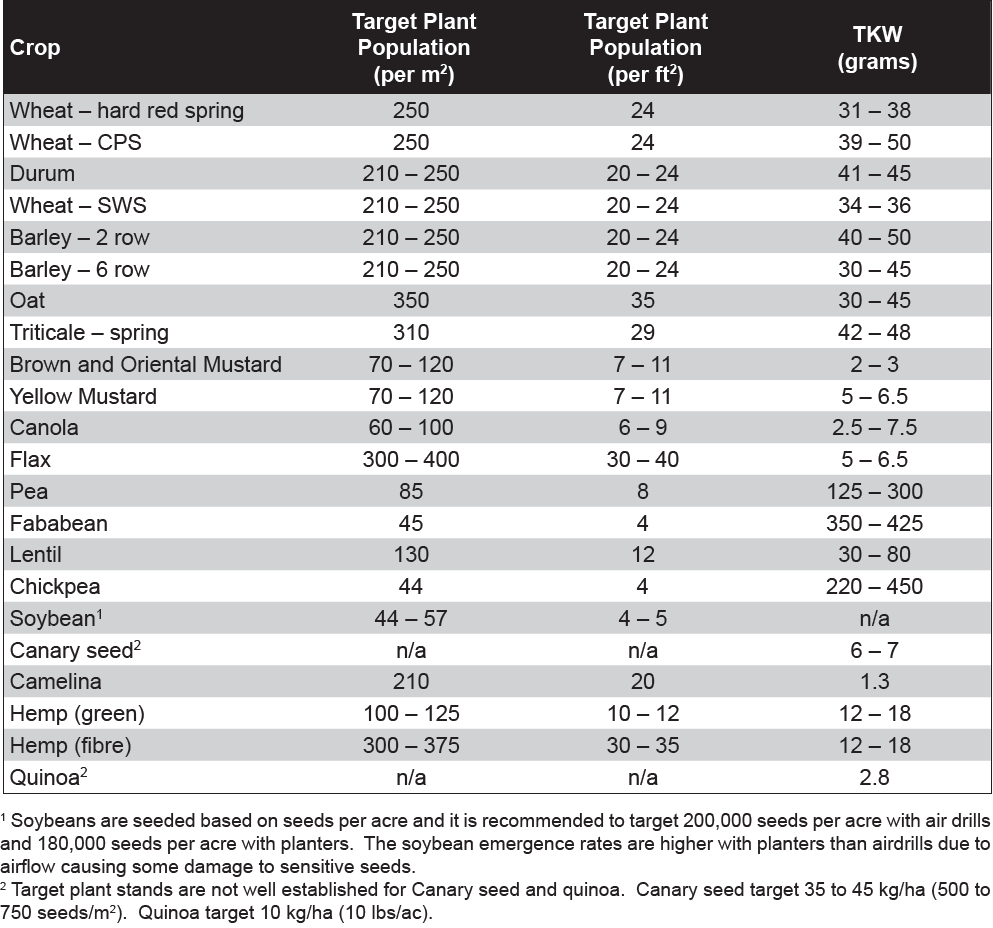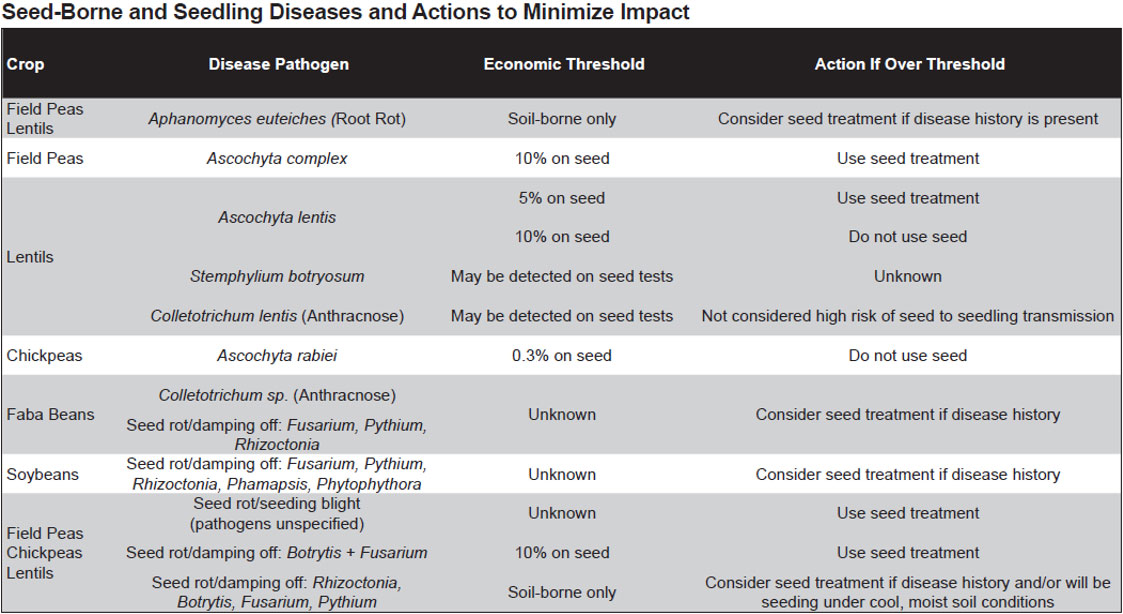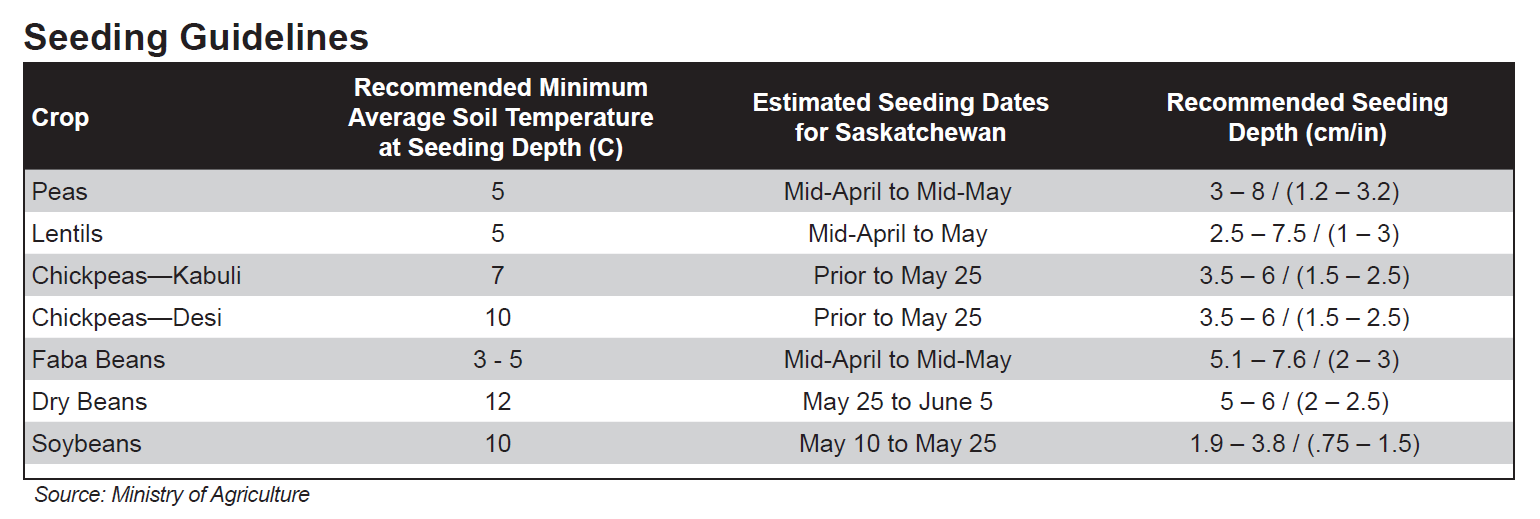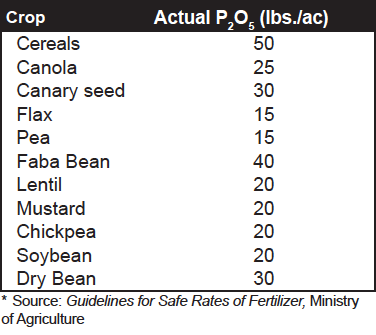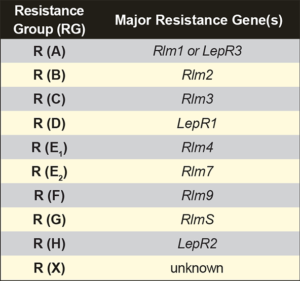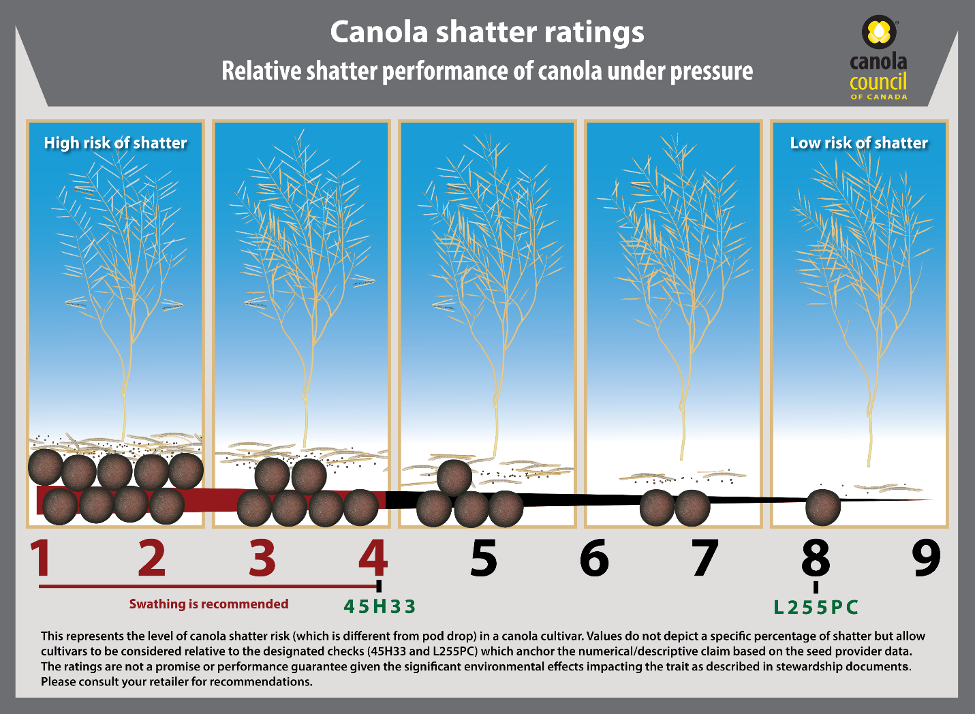Resources for Selecting and Planting Seed
The cropland of Saskatchewan has been divided into four areas based roughly on agro-climatic conditions. Crop yields can vary from area to area. In choosing a variety, producers will want to consider the yield data in combination with marketing and agronomic factors.
Area 1: Drought is a definite hazard and high winds are common. Sawfly outbreaks often occur in this area. Cereal rust may be a problem in the southeastern section.
Area 2: Drought and sawfly may be problems in the western and central sections of the area. Cereal rust may be a problem in the southern section.
Area 3: Sawfly can also be a problem. Drought is not as likely to be a problem in this area, particularly in the east. Cereal rust may occur in the eastern portion. The frost-free period can be fairly short in the northern section.
Area 4: Rainfall is usually adequate for crop production. However, early fall frosts and wet harvest conditions are frequent problems.
Note About Dividing Lines:
The dividing lines do not represent distinct changes over a short distance. The change from one area to another is gradual.
By The Ministry of Agriculture
Grower dollars at work testing varieties of grain crops across Saskatchewan. Variety results are reviewed and approved by SACGC to ensure information published is based on sound scientific principles.
Regional testing of crop varieties is conducted to provide producers with information on the agronomic performance of varieties under different agro-climatic conditions. Saskatchewan producers will continue to have the opportunity to evaluate the newest grain crop varieties and their suitability for production in different regions of the province. Many funders contribute to variety testing in Saskatchewan.
The Ministry of Agriculture provides $100,000 toward a testing program that is based on industry-government partnership. Technical and in-kind support is also provided by Agriculture and Agri-Food Canada, Saskatchewan Crop Insurance Corporation and The Western Producer, publisher of the 2025 SaskSeed Guide.
The Saskatchewan Variety Performance Group (SVPG) administers the program for spring cereals, fall rye and flax. SVPG is composed of representatives from the seed industry, producers, breeders and government. The SeCan Association administers the funds for SVPG. Crop coordinators manage the data and provide expertise for their respective crops. An entry fee system is used, in which variety owners or companies with the distribution rights to a particular variety pay a portion of the cost of having the variety tested. The Saskatchewan Seed Growers’ Association, Saskatchewan Wheat Development Commission, Saskatchewan Barley Development Commission, Saskatchewan Oat Development Commission, SaskFlax and Saskatchewan Cattlemen’s Association collectively provide more than $100,000 to the core program. Supplementary funds enhance the core program.
Saskatchewan Pulse Growers (SPG) funds the pulse and soybean regional variety trials for Saskatchewan growers. For the 2024 trials, this funding was approximately $440,000 which is partially off-set by entry fees for varieties entered into the trials resulting in SPG funding over 64% of the total cost. SPG collaborates with 15 research organizations at 24 locations to conduct the trials, Including the Crop Development Centre at the University of Saskatchewan, Agriculture and Agri- Food Canada research stations, provincial AgriARM sites, Saskatchewan Irrigation, New Era Ag Research, Condie Genetics, Parkland Crop Diversification Foundation, SM Ag Research, Palliser Triangle Research, Discovery Ag Research and the Conservation Learning Centre.
Canola Performance Trials represent the next generation in variety evaluation for Western Canadian canola growers. The three Prairie canola grower groups – Alberta Canola Producers Commission, Saskatchewan Canola Development Commission (SaskCanola) and the Manitoba Canola Growers Association – fund the program.
The results from all variety trials of all crop kinds tested are reviewed by the Saskatchewan Advisory Council on Grain Crops (SACGC), which also updates disease and other agronomic information and approves the data prior to inclusion in this publication.
Relative yield of varieties
Trials are conducted using uniform protocols and standard check varieties. Data is collected from as many sites as are available and statistically analyzed. Results in this publication are aggregated over a number of years and on an area basis for most crops.
Grain yield is a function of genetic and non-genetic factors. Variety trials are designed to measure yield differences due to genetic causes. It is important to minimize variability due to non-genetic factors such as moisture, temperature, transpiration, weeds, diseases and other pests. Experimental design uses replication (repeated plantings of the varieties) and randomization (the position of the varieties within the test is assigned by chance) to estimate the precision with which the genetic factors can be measured.
Relative yield is the yield of one variety expressed as a percentage of the check variety. Yields obtained in these trials are not identical to those obtained in commercial production. However, the relative ranking of these varieties compared to the check variety, obtained over a number of years at several locations, would remain the same regardless of whether the grain yield was measured in small plots or large-scale fields. Relative yield is the best estimate of expected yield advantage in the areas indicated.
There are various factors to consider when selecting a new variety and it all depends on what your main priority is. Some factors to consider include:
- Market – Identify your target market and make sure the variety selected matches the specifications and quality expected by your buyers, such as seed size, colour, functionality and other attributes.
- Maturity – Identify realistic expectations on maturity needed to achieve optimum yield and quality in your region.
- Disease resistance – Select varieties with better resistance for high-risk areas or fields. Resistance helps with disease management, but may or may not reduce the reliance on fungicide application.
- Herbicide tolerance – Consider the weeds or volunteers that may be present in the field to determine if herbicide-tolerant options are a good choice.
- Seed size – If seed size does not affect the market choice, then consider the seeding costs of the variety. Smaller-seeded varieties are usually cheaper to seed and have fewer production issues with plugging seeding equipment and other operations. Faba beans are a good example where seed size may be an important consideration.
- Crop growth habit and other physiological factors – Factors such as growth habit (determinate or indeterminate), plant height, standability, harvest management and quality parameters such as resistance to sprouting, seed coat breakage and bleaching.
- Yield – This is often the highest priority, as it directly relates to the ultimate goal of net return. In some cases, the advantages and higher performance of new varieties may not necessarily translate into higher yield, due to environment or management practices. If all other factors have been considered, then use yield potential as the deciding factor.
By The Ministry of Agriculture
The goal of the Plant Breeders’ Rights (PBR) legislation is to encourage investment and innovation in the crops sector. There are many ways to accomplish this, but the International Union for the Protection of New Varieties of Plants (UPOV)-based PBR balances the interests of the farmer and the breeder. This gives the farmer fair access to the use of purchased seed and the breeder can expect a royalty from every farmer buying seed of the breeder’s variety.
PBR protection helps ensure that companies and institutions that invest in plant breeding can keep reasonable control of their varieties and secure fair compensation for their efforts. Some of the benefits of PBR include:
- Access to new and improved plant varieties and improving the bottom line for producers. Enhanced protection under the revised PBR Act will encourage the introduction of new varieties from other countries (once registered in Canada), as well as stimulate investments in variety development in Canada.
- Farmers may save seed for use on their own farms if the original seed was obtained legitimately. However, seed may not be sold for sowing, without the consent of the breeder.
Plant breeders’ rights are a form of intellectual property rights that allow plant breeders to protect new varieties of plants. When plant breeders’ rights are granted, the breeder gets exclusive rights in relation to propagating material (e.g. seed) of their new plant variety. Sale, trade, exchange, or any other transfer of the seed for propagation purposes is prohibited by law without the written permission of the breeder or their agent.
Varieties protected by PBR are identified with one of two logos. Varieties protected prior to Feb. 27, 2015, are identified by:

and those protected on or after Feb. 27, 2015, are identified by:

Varieties previously protected by PBR re-main under the same rules as before. Varieties protected since Feb. 27, 2015, are protected under the new PBR Act.
The new PBR Act provides additional mechanisms for the breeder to seek compensation for the unauthorized use of protected varieties. It has always been illegal to sell PBR-protected seed without the consent of the breeder. Now, it is also illegal to purchase seed without the consent of the breeder, meaning both the seller and purchaser can be liable if the seed sale is not approved. The best way to ensure that the seed is being purchased legally is to purchase certified seed. Producers should look for the blue certified seed tag and keep it in their records as long as they grow grain derived from that original seed purchase.
Canada’s initial PBR Act facilitated access to new and improved varieties for farmers. With the updated PBR Act, farmers will benefit from even greater access to new or improved crop varieties and breeders will be better able to protect the investments in the development of new varieties.
For more information, visit www.seeds-canada.ca or contact the PBR Office at pbr.pov@inspection.gc.ca.
Plant Breeders’ Rights status can change throughout the year. Significant efforts are taken to ensure the correct logo is applied at the time of printing this guide. The PBR Office maintains a web page that can be accessed to verify accuracy and/or changes to the PBR status of a variety.
UPOV is the International Union for the Protection of New Varieties of Plants. To be a member, a country must have legislation that aligns with a ratified UPOV convention. There are 78 UPOV member countries, 61 of which have ratified UPOV’91-compliant legislation.
VARIETY USE AGREEMENT
A Variety Use Agreement (VUA) will be applied to specific varieties as determined by plant breeders and their seed distributors. When producers purchase a VUA variety and then divert some of that grain at harvest for seed use and plant it the following spring, they will declare that use in the VUA Platform and will then be invoiced a Variety Use Fee for use of the variety. This royalty fee, which is set at the time of certified seed purchase, will be invoiced to the producer every year that farm saved seed of the VUA variety is grown.

Varieties with a VUA will be designated in this guide with VUA symbol following entry in the data tables. The VUA platform is managed by Seeds Canada. For more information, visit: www.seeds-canada.ca/variety-use-agreement.
By The Ministry of Agriculture
Seed quality and seeding rates are important for establishing good plant stands and unlike the weather, are two factors we can control. Plant population sets the stage for the yield potential of a crop. Research has shown that each crop has an optimum plant density range that producers should target when seeding their crop. Rates may be adjusted depending on the conditions in the field, date of seeding, weed pressure, seed-placed fertilizer and other pressures that may affect emergence or plant stand.
Determining the quality of the seed starts with a seed test prior to buying seed or seeding the crop. Sending a seed sample to a qualified lab can provide information on germination, vigour, diseases present, purity and thousand kernel weight (TKW). All of these factors help inform growers of whether the seed is suitable for planting and influence seeding rates for that seed lot. Germination tells us how many seeds are expected to germinate and vigour gives an indication of how well the seedlings will thrive under stressful conditions. TKW provides the seed size, which is vital when calculating seeding rates to target optimum plant populations. Average TKW for varieties are listed in the Varieties of Grain Crops, but individual seed lots can vary tremendously. Having the actual TKW for the seed lot being grown is important for the accuracy of seeding rates.
Changes in the canola seed industry require you to pay closer attention to seeding rates, or to change how you approach seeding. Companies are selling seed based on categories of seed size, represented by thousand seed weight (TSW).
The majority of canola seed today falls into a TSW range of 4.0 to 5.9g. The TSW is currently listed on a bag, but each bag is equal weight and price; thus, the number of seeds between bags with different TSWs might be inconsistent. Bag weights will differ between each TSW category, but the number of seeds per bag will be much more consistent across TSWs listed on the bags; germination and vigour will not differ. Pricing should remain consistent, as well, regardless of bag weight. The important consideration to note is that seeding rate must be adjusted accordingly to achieve consistent establishment (and plant stand density) across any of the TSWs.
Calculating Seeding Rates
Thousand kernel weight (TKW), germination rate and target plant populations are needed when calculating the seeding rate. Crops and varieties can vary significantly in seed size, especially pulses and not knowing your TKW could mean seeding too heavily and spending more on seed than needed, or seeding too lightly and limiting yield potential. Emergence rate is more difficult to estimate, as it is dependent on germination and environmental conditions.
Expected seedling survival is typically five to 20 per cent less than the germination rate with pulses and cereals — more under ideal conditions and less under adverse conditions. For canola, expected survival rates range from 40 to 60 per cent. Factors to take into account when determining the expected seedling survival are seeding date, soil temperature, moisture and texture, as well as seed quality and possible soil-borne diseases and insect pressures. The amount of seed-placed fertilizer and the seeding depth are factors that can also affect seedling survival. The formula below should be used to determine the target seeding rate:
For example: With CDC Amarillo yellow peas, the target plant population is 85 plants/m2. A seed lot with TKW of 235 grams and germination at 98 per cent under good emergence conditions (using 88 per cent emergence, which is 10 per cent less than the germination rate) would have a target seeding rate of: 85 x 235 / 88 = 227 kg/ha, or 202 lbs./ac. or 3.4 bu./ac.
By Jason Danielson, Discovery Seed Labs
Seed testing can give an indication of how fit your seed is for planting. Tests should be done for germination, vigour and disease. This package of tests can help you better understand how suitable seed will be for spring.
The germination test will give you an indication of the percentage of seeds that will grow in an ideal growth environment. The vigour test indicates the percentage of seed that will grow in adverse conditions. Even though the vigour assay is not standardized between seed labs, the results should be indicative of the seed’s fitness when grown in harsher conditions. Combining the information from the germination and vigour tests will give you a good snapshot of the fitness of your seed.
Ideally, the germination rate from your sample should be higher than 85 per cent. The vigour should be close to the germination value; but if there is variation, it should be no greater than 10 percentage points. A large difference could be an indication of issues in the seed, especially if storage conditions over the winter months are not ideal.
Challenging harvest conditions can decrease the viability of the crop for seed. A germination test in the fall may not be representative of the germination in the spring, after several months of storage. A fall germination test can be helpful in determining seed needs for the upcoming year. A germination test closer to spring is recommended to ensure the seed remains sound for spring planting.
Grain dryers can be used on crops intended for seed, but the grain dryer must be kept at temperatures safe for the seed. High temperatures in grain dryers can reduce germination. For more information on grain drying and storage, visit www.saskatchewan.ca and search “drying grain.”
If forced to use seed with a lower germination rate, you will have to increase the seeding rate to reach your target plants per square foot. Keep in mind that you cannot just increase the seeding amount by the percentage you are off from 100 per cent as not all of the seeds you are adding to the increased seeding rate will germinate. A seeding rate calculator can be a helpful tool to determine the correct seeding rate.
Significant time between when your test was completed and when seeding will occur can result in your germination and vigour values dropping. You can retest your seed in the spring to determine if germination has changed from the initial test in the fall.
When performing your own germination tests, it can be challenging to determine if a seed has germinated and is healthy, versus a seed that develops weak roots that won’t grow into a plant. Other issues such as fresh and hard seeds, in addition to seed dormancy, can lead to inaccurate results. A certified seed analyst is trained to conduct seed tests.
There are different diseases of interest depending on the crop that you are seeding. For cereals, the main diseases to test for are Cochliobolus sativus (root rot), Ustilago nuda (smut) and Fusarium (root rot) — both Fusarium graminearum and total. Although F. graminearum is not the most aggressive Fusarium species for seedling blight, any areas that have not had fusarium head blight (FHB) caused by F. graminearum should avoid introducing it. The Fusarium total reported on the seed test includes F. graminearum.
For pulses, the diseases of interest are Ascochyta (leaf blight), Anthracnose, Botrytis (grey mould) and Sclerotinia (white mould). The amount of disease pressure during the last growing season will determine what you will likely have available for quality of seed.
A good practice is to always use the best seed you can source. In good years you should look for seed with little to no presence of disease. In challenging years when the disease is higher, it is important to still source the best seed available and be sure to use seed with good germination.
When using seed with high disease and low germination, more seed is needed to achieve the target plants per square foot. Increasing the seeding rate increases the amount of disease inoculum that you are adding to your soil. A seed treatment can be a good investment in a variety of scenarios, including when using seed with higher disease levels.
Soil Germination Test
It is important to communicate if the crop intended for seed has been treated with pre-harvest glyphosate. Otherwise, the seed will be tested in a normal germination test and the glyphosate may adversely affect germination. This adds an additional cost because the sample will have to be retested for germination. If there is a possibility of glyphosate on the seed, a soil germination test should be requested to “tie up” any glyphosate that might be on the outside of the seed so it does not have adverse effects when the seed is germinating.
Some crop desiccants are registered for use on crops intended for seed production. Glyphosate is not a desiccant. Glyphosate is not recommended for any crop that is to be used for seed. Glyphosate at pre-harvest can cause germination and possibly vigour problems if the herbicide was applied before the seed was fully mature. Crops sprayed with pre-harvest glyphosate may germinate, but the seedling could be stunted and deformed. Crops treated prematurely are off-label and have the potential to threaten export markets.
Seed Samples
The quantity of seed tested is minuscule compared to the size of the seed lot that it represents. Improper sampling is the greatest source of error in seed testing. Make certain the sample is representative of the entire seed lot. To collect a representative sample, gather more seed than needed for a given test. Hand sample or use a probe so that all areas of the seed lot are represented. If the seed is in a bin, sample it from the top, centre, sides and bottom. Do not take your seed sample from beside the bin door. It might be more appropriate to collect subsamples as the seed is being transferred from a truck or bin. After collecting the seed, thoroughly mix it.
Regardless of how accurately the technical work is, the results can only show the quality of the sample submitted for analysis. Consequently, every effort must be made to ensure the samples sent to the analyst accurately represent the composition of the lot in question.
Use of seed from cereal crops infected with Fusarium species may result in poor emergence. Such seed should be treated with a registered fungicide before planting. Use of infected seed may introduce Fusarium diseases into unaffected areas. Tolerance for Fusarium vary with species. Refer to the Ministry of Agriculture publication Seed Quality and Seed-Borne Diseases of Cereal Crops for more information.
Smuts that attack wheat, barley, oat and rye can be controlled by seed treatment. If seed from a crop in which bunt or smut was observed must be used for seed, seed should be tested and seed treatment should be considered. If the presence of smut is uncertain, varieties rated susceptible (S) should be treated every year, those rated moderately susceptible (MS) every second year and those rated intermediate resistance (I) every third year.
Only systemic fungicides will control true loose smut of barley and wheat and stem smut of rye. Pathogens causing the other types of smut (covered, false loose, oat smut and bunt) are carried on the outside of the seed and can be controlled by non-systemic seed treatments.
The virulent form of blackleg of canola is widespread in Saskatchewan. Seed treatment with a recommended fungicide can reduce the level of disease. Use of canola seed commercially coated with an appropriate seed treatment is a convenient alternative to on-farm seed treatment.
Pulse growers should use seed that has been tested for seed-borne diseases such as ascochyta, anthracnose and botrytis. Tolerances for seed infection vary with the pulse crop, the disease, weather conditions of the region and the availability of a seed treatment. If infection of the crop from sources other than seed is likely, using seed with low infection levels becomes less important. In regions with frequent rainfall and high humidity, tolerances will be lower.
For ascochyta blight of lentil, use of seed with up to five per cent seed infection is acceptable in the Brown and Dark Brown Soil Zones, but zero per cent is desirable in the Black Soil Zone. A seed treatment for ascochyta-infected lentil seed is available and is recommended if seed infection levels approach five per cent. In pea, up to 10 per cent seed infection with ascochyta is acceptable.
In chickpea, zero per cent ascochyta seed infection is recommended because of the high rate of transmission of the disease from the seed to the emerging seedlings and its highly destructive nature. Refer to Saskatchewan Agriculture’s publication Seed Quality and Seed-Borne Diseases of Pulse Crops.
Handle delicate seeds (i.e., pulses) with care, as seed coats are susceptible to damage—run augers full and slow and watch fan speeds on airseeders. Use a seed treatment if seeds have a high level of disease, show signs of mechanical damage, or the forecast is for wet, cool environmental conditions that may delay emergence. Kabuli chickpeas must have seed treatment or reduced emergence will occur.
Root rots can include a complex of pathogens such as Fusarium spp., Rhizoctonia solani, or Pythium spp. and, more recently, Aphanomyces euteiches. There is no indication of differences in susceptibility between varieties or crops for most of the root rot pathogens, with the exception of Aphanomyces. Currently all pea and lentil varieties are susceptible to Aphanomyces root rot. Current faba bean and chickpea varieties have partial resistance and, along with soybean, could be considered other nitrogen-fixing crops that have resistance to Aphanomyces.
With soybeans, the best management practices for Phytophthora stem rot include selecting varieties with genetic resistance and using a seed treatment that is labeled for control.
Wireworms that attack all grain crops, pea leaf weevil in pea and faba beans and flea beetles that attack canola and mustard can be controlled by seed treatments containing insecticides.
The degree of control with seed treatments depends on five factors:
- active ingredients
- rate of application
- seed- and soil-borne fungal diseases or insects present
- environmental conditions
- quality of seed coverage.
Check individual product labels for specifics.
Adequate coverage is important to ensure each seed is protected and the seeds are completely covered (especially important with contact type seed treatments).
Read the label carefully before using any seed treatment. Information on their use and recommended rates is found in the Ministry of Agriculture publication Guide to Crop Protection. Carryover stocks of treated seed should be tested for germination before planting. Treated seed must not be delivered to an elevator or used for feed.
By The Ministry of Agriculture
Resistance to the most important diseases in Western Canada is assessed in most crops as part of the variety registration process. The methods used to assess resistance in each crop are different. In some cases, spores of the pathogen are applied to plants in the greenhouse or in the field. In other cases, assessment is based on naturally occurring infection in the field. Each variety for the applicable crops is rated on a five-point scale of Resistant (R), Moderately Resistant (MR), Intermediate Resistance (I), Moderately Susceptible (MS) and Susceptible (S).
Because of variation in disease levels from year to year, each new variety is assigned a rating relative to a few existing varieties that serve as disease level standards or checks. Varieties differ in resistance because of differences in their genetic makeup and/or differences in the genetic makeup of the pathogen that causes the disease. However, the genetic makeup of a pathogen can change over time and can enable the pathogen to overcome the resistance in a variety. In such cases, a variety with good resistance can quickly display poor resistance to a particular disease. Unfortunately, because not all varieties are tested side-by-side every year, the ratings of older varieties may be less reliable.
Preserving the efficacy of disease resistance genes in current crop varieties is the most economical method of plant disease control. Disease resistance can be prolonged with good agronomic and integrated pest management practices. Crop type, variety and fungicide rotation are important methods of preserving the effectiveness of disease resistance genes and fungicides. Disease resistance genes usually become ineffective due to short rotations and the prolonged use of one crop variety on a large acreage.
A number of factors can affect the level of disease symptoms observed at a given location in a given year. Environmental conditions such as moisture and temperature, the genetic makeup of both the variety and the pathogen and the amount of the pathogen present can all affect the level of disease. Although a variety with Intermediate (I) resistance can show disease symptoms under favourable conditions, a Susceptible (S) variety would have much more disease under the same conditions.
For example, ascochyta blight of chickpea is a very aggressive fungal disease. It can completely kill Susceptible (S) varieties within two weeks of symptoms first appearing. Chickpea varieties currently grown commercially in Saskatchewan have Intermediate (I) ascochyta blight ratings. This resistance weakens as plant development nears the flowering stage.
By The Ministry of Agriculture
Fusarium head blight has recently become more common in Saskatchewan. Producers will find out the level of fusarium-damaged kernels (FDK) and perhaps DON (deoxynivalenol) on their grain from the elevator. However, Fusarium infection levels are needed to determine seed quality.
FDK does not provide the whole story regarding Fusarium infection. FDK is a measure of grain quality, not seed quality. Seed can be infected by Fusarium even when FDK are not present.
Fusarium spp. can infect the plant at different stages of the kernel development. Early infection may lead to an aborted floret, while later infection may leave spores on the kernel without showing visual symptoms. Tombstone kernels (FDK) are infected between those extremes.
Because there is no correlation between FDK and Fusarium infection of the seed, FDK cannot be used to predict Fusarium infection levels. A disease test is needed to determine if seed has Fusarium spores on it that could cause seedling blight or root rot.
Fusarium infection on the seed can sometimes be managed with a seed treatment. Fusarium graminearum is a particularly aggressive form of fusarium head blight, so recommendations are to prevent its introduction into new areas.
Seed treatments are used to manage seedling blights caused by Fusarium spp. The primary source of fusarium head blight infection is infected residue. Seed is not considered a contributing factor to fusarium head blight.
In areas where F. graminearum is not established, seed with more than five per cent F. graminearum is not recommended for planting. Seed with two to five per cent F. graminearum should be treated with an appropriate seed treatment.
F. graminearum now has a wide distribution in Saskatchewan, so, for most producers, a seed treatment should be used when total Fusarium species is greater than 10 per cent.
If seed is tested early in winter, germination should be retested again in the spring, especially if disease is present. Germination can decrease during storage.
For more information, refer to the Ministry of Agriculture publication Seed Quality and Seed-Borne Diseases of Cereal Crops.
By The Ministry of Agriculture
Maturity is measured from seeding to physiological maturity, which is the stage at which the crop is at the appropriate ripeness for swathing. The actual number of days to reach maturity depends on local climatic conditions and, to some extent, on management practices.
Some of the tables in this booklet express the relative maturity in days while others use a five-category scale: VE, E, M, L and VL (very early, early, medium, late, very late). The limits for each category can vary from crop to crop. In barley, for example, AAC Synergy would be M, with L and E varieties plus or minus one to two day and VL and VE varieties beyond this range.
Comparisons
The relative maturity of varieties of different crops is important when making plans for seeding.
The chart below compares the relative maturity ranges for crops grown in Saskatchewan. Within each crop there are early and late maturing varieties. Whether a crop matures before the first killing frost depends on seeding date, management practices and environmental factors. Not all crops have a wide area of adaptation.
It is noted that climatic conditions can cause a wide variability in crop maturity.
Understanding Soybean Maturity Ratings
Soybean maturity ratings are currently based on three approaches: corn heat units, maturity groupings and days to maturity. The preferred ways to measure soybean maturities are through maturity group classifications or days to maturity. The maturity group (MG) rating system classifies soybean varieties from MG 000 in northern areas to MG IX in southern areas of North America, based on latitude ranges and photoperiod sensitivity. Each MG region covers one or two degrees of latitude, or about 200 to 300 km from north to south. For Saskatchewan, soybeans are most suited with 00 and 000 MG. Each MG can have subgroupings with a zero to nine decimal number following the group (or zone) number and these decimal places equate to slight increases in maturity. In the 00 maturity ratings, a subgroup of 00.1 would be earlier maturing than 00.9. Note that these MG ratings are not entirely standardized between seed companies. Check with your seed supplier to better understand MG ratings. Days to maturity is a direct measure of the days each variety takes to reach physiological maturity and is averaged across locations. The lower the number, the earlier-maturing the variety was across the sites tested. This value is obtained through the Regional Variety Testing Program and is an independent rating. Growers are advised to use all maturity information available to choose appropriate varieties for their area.
PEDIGREED SEED
Use certified seed regularly. This assures that the seed has high genetic purity and high germination and is relatively free from weeds and other crop seeds.
RE-USE OF HYBRID SEED
Seed grown from a hybrid variety (regardless of crop or variety) should not be re-used, since a 20 to 25 per cent yield reduction can occur in the next generation. This reduction is due to loss of hybrid vigour and possible occurrence of male-sterile plants. Lack of uniformity for maturity and quality traits can also occur.
SEED CLEANING
Seed should be cleaned carefully to remove weed seeds, trash, small or broken kernels, ergot and sclerotia. Not all seed-cleaning plants are equipped to clean grain to acceptable seed standards.
CROP ROTATION
Seeding into stubble of the same crop kind will increase disease risk, particularly in higher rainfall areas. Residue of infected crops may harbour disease pathogens. Maintain a diverse crop rotation.
ERGOT
Ergot attacks all varieties of rye, triticale, wheat and barley, as well as most common grass species. Oat is rarely attacked and all broadleaf species are immune. Grain containing 0.1 per cent ergot is considered poisonous and should not be used for food. Refer to the Ministry of Agriculture publication Ergot of Cereals and Grasses.
DAMP AND FROZEN SEED
Seed that is stored damp or tough may be low in germination and may lack adequate vigour. Grain that will be used for seed should be dried, if necessary, soon after harvest. The drying temperature should be below 37 C for batch driers and 43 C for recirculating and continuous driers. Ensuring the grain is dried at a low temperature will help to maintain a viable embryo and germination rates. Frozen grain should always be tested for germination by a seed-testing laboratory before planting. Such grain will frequently produce a high percentage of abnormal seedlings.
WHEAT MIDGE
All wheat classes, including durum and triticale, are susceptible to wheat midge. Producers in infested areas should be prepared to spray fields with recommended insecticides if necessary, unless varieties are midge-tolerant. Consider the use of midge-tolerant varieties. Refer to the Ministry of Agriculture publication Wheat Midge – Overview and Control Methods.
Phosphorus (P) is an important plant nutrient. Phosphorus promotes the development of extensive root systems and vigorous seedlings. Encouraging vigorous root growth is an important step in promoting good nodule development and nitrogen fixation for all legumes and growth of all crops. It also plays an important role in promoting earlier and more uniform maturity in all crops. Maximum safe rates of actual seed-placed phosphate fertilizer vary by crop and are based on knife openers with a one-inch spread, nine-inch row spacing and good to excellent soil moisture. For wider rows and/or narrower seed spread behind the opener, or under dry conditions, the maximum safe rates would be lower. These recommendations are based on monoammonium phosphate (11-52-0), which has a relatively low salt index and should not be used for other fertilizers. The table at right summarizes the maximum safe rates of seed-placed phosphorus (P2O5) fertilizer in narrow row systems based on knife openers with a one-inch spread, nine-inch row spacing and good to excellent soil moisture. Wider row spacing and/or narrower seed spread openers would have reduced tolerance and safe rates should be adjusted lower.
Inoculants contain the nitrogen-fixing Rhizobium species necessary to ensure nodulation and nitrogen fixation. Rhizobium species are specific to each pulse crop. Pea, lentil and faba bean inoculants contain the same Rhizobium species, but the individual strain of that species (similar to varieties of crops) may be more effective on one crop or another. Make sure to use the right inoculant for each crop.
Handling Inoculants
Inoculants are products that contain living organisms and should be handled accordingly. Avoid exposure to direct sunlight, heat or freeze-thaw conditions. Consider application method when using in combination with seed treatments, as fungicides can impact Rhizobia survival. For best results, apply seed treatments first, allow the seed to dry, then apply the inoculant if using seed-applied products (sequential application). Read inoculant and seed treatment labels for more information on seed compatibility.
Inoculant formulations consist of seed-applied technologies such as liquids, peats and powders, as well as granular formulations. Single inoculant applications are effective for peas, lentils, chickpeas and faba beans. For soybeans, it is recommended to use a double inoculation strategy such as a seed-applied product in combination with a granular formation, on land where soybeans are being grown for the first time. To date, no benefit of double inoculation on other pulse crops has been identified.
By Matthew Bernard, Saskatchewan Agriculture
Blackleg is best managed through an integrated approach that includes extended crop rotations, scouting to monitor disease levels, use of blackleg-resistant canola varieties, use of disease-free certified seed and use of fungicides to prevent early season infection when warranted. As in any living organism—including plants and fungi—genetic diversity exists in populations of the blackleg-causing pathogen, Leptosphaeria (L.) maculans. This diversity can affect its ability to infect a plant. The genetic diversity in L. maculans is referred to as different “races.” Blackleg-resistant canola varieties can include both major gene resistance, as well as minor gene resistance (quantitative resistance). Major gene resistance can provide complete resistance when there is a match between the specific genes in the pathogen race (avirulence/virulence genes) and the major gene in the resistant canola variety. On the other hand, minor gene resistance is not race-specific and will provide the same level of protection against all races of the pathogen. This type of resistance is not complete but is a stable form of resistance that will reduce the severity of infection. When a pathogen population is exposed to the host (canola) in high frequency, higher selection pressure is put onto the pathogen population, which results in shifts in the pathogen population, favouring races that can cause infection in a resistant canola variety grown in the field.
Industry has recently adopted a more detailed genetic-based, voluntary labelling system for blackleg resistance, where available. Major genes, or groups of genes, are represented by a lettering system referred to as Resistance Groups (RGs):
Due to the complexity of the genetics, some hybrids might include one or several groups. Highly similar genetics are labelled accordingly, which is why there might be sub-categories (such as R (E1 ) vs. R (E2)). Also, group names might change or new groups might be added in the future, as researchers discover more about the interactions.
Knowing the genetics and RG of the variety that you are growing is helpful in making informed variety rotation and blackleg disease management decisions, but it is only part of the tool. It is also important to understand the pathogen race(s) present in your field, which can be accomplished by stubble testing. When these two pieces of information are known, and other parts of an integrated management approach are being employed, the resistance in the canola plant can be optimized by choosing a variety in a specific RG to combat the pathogen race(s) present in your field most effectively. The “rotation” of these genetics should not be shuffled on an annual basis, but rather when there is evidence that the entire integrated approach is no longer effective (which includes extended rotations and other approaches discussed). This can be determined through late-season scouting and disease severity rating. If blackleg levels remain low; that means your resistant variety is effective. However, if blackleg disease levels increase, there may be a mismatch between the major gene resistance in your variety and the pathogen race in the field. When this occurs, you can refer to the RG list to select a different blackleg-resistant variety. No one tool will be a sole option for blackleg management on your farm, but being aware of, and knowing how to use, all of the tools available will be the most effective way to implement an integrated pest management strategy to minimize disease severity and maximize returns. For more information, visit www.blackleg.ca.
Stubble tests to determine races present in your field can be performed at several labs, including Manitoba’s Pest Surveillance Initiative Lab (Winnipeg), Discovery Seed Labs (Saskatoon) and 20/20 Seed Labs (Winnipeg and Nisku).
By SaskCanola, Saskatchewan Ministry of Agriculture and Canola Council of Canada
Canola variety registration process in Canada
The Western Canada Canola/Rapeseed Recommending Committee (WCC/RRC) is responsible for determining which new canola varieties are recommended to the CFIA for registration. This recommendation is based on a several parameters and quality standards such as oil, protein, chlorophyll, saturated fatty acid content, disease tolerance, yield and more. The WCC/RRC has influence on current industry standards and oversees the testing procedures that are agreed upon by members to evaluate new varieties for merit. They select the check varieties which are used, ensure they meet the standards and then recommend the varieties for registration to the Canadian Food Inspection Agency Variety Registration Office (CFIA-VRO). As the Committee makes these decisions, it also considers the breeding possibilities for future varieties.
Members of this Committee represent all sectors of the value chain including growers, breeders, pathologists, exporters, processors and crushers, the Canadian Grain Commission, seed growers, CFIA and the CFIA-VRO (non-voting observer).
On behalf of the WCC/RRC, Canola Council of Canada staff coordinate the testing of pre-registration varieties and research trials at many locations across the Prairies. This provides the board with adequate information to make decisions about each potential variety.
Public co-op trials are designed to evaluate the agronomic, quality and disease resistance attributes of canola cultivars. The data collected is combined with previous years’ private co-op trial data. Evaluation comparisons are derived from data based on glucosinolates, erucic acid, oil content, saturates, protein and blackleg testing for information purposes. There is a two-step process for a variety to become registered. The first step is the interim recommendation for registration based on one year of private co-op data. A minimum of 12 site years of valid data, collected over one year of private co-op testing is normally required for consideration of candidates for interim registration. The second step is the recommendation for full registration based on one year of private and one year of public co-op trial data. A minimum of 10 additional site years of data, collected over three or more years, is normally required. In the past few years, the WCC/RRC has recommended up to 28 interim and 85 full registrations each year.
The WCC/RRC has sub-committees for various topics including the Specialty and Contract Registration Subcommittee (reviews and recommends rapeseed cultivars such as varieties for industrial use or specialty oil profiles), the Plant Pathology, and Canola Quality.
For more information on the canola variety registration process visit www.canolacouncil.org.
Understanding Clubroot Resistance and the Classification System
Clubroot resistance in a variety should be substantiated through standard testing procedures outlined in the WCC/RRC guidelines and protocols. Varieties are compared to the susceptible check variety for clubroot infection and are assigned resistant (R), intermediate (I) or susceptible (S) ratings.
Resistant (R) ratings indicate less than 30 per cent infection compared to susceptible checks in disease tests. It is important to remember that resistant (R) varieties are not immune, but highly restrict the development of clubroot symptoms in fields with low-to-moderate disease pressure from resting spores in the soil. Under heavy pressure in severely infested fields, a resistant (R) variety can show significant root galling but may develop fewer and smaller galls than a susceptible variety. Under these heavy pressure situations and with frequent use of
clubroot-resistant varieties, clubroot populations rapidly shift to overcome genetic resistance. To delay this shift in clubroot strains and loss of clubroot-resistant variety efficacy, clubroot-resistant varieties should not be grown in short rotations. Currently in Saskatchewan, we have not seen resistance breakdown and we may have fewer resistance breaking pathotypes, which shows that we are doing a good job of preserving the resistance that we have.
Intermediate (I) ratings indicate between 30 and 50 per cent infection compared to susceptible checks in disease tests. This rating is used for adding labels to the base resistance (R) label in multiple resistance gene varieties. This helps to specify moderate resistance against certain new strains. Varieties with additional intermediate (l) labels can provide marginally better disease protection in fields with the presence of new corresponding strains but should not be grown in fields where resistance to predominant strains has been widely defeated.
If there is no clubroot label on a variety, assume it is susceptible to clubroot. An extreme buildup of spores can occur very quickly when susceptible varieties are grown in short rotation on slightly infected fields. Susceptible varieties should not be grown in clubroot-infested fields, or those at higher risk of becoming infested.
A base (R) resistance label requires that the variety is resistant to the predominant clubroot strains or pathotypes in Western Canada. Additional ratings can be appended to the base (R) label to describe resistance to specific uncommon or new pathotypes. To date, no clubroot resistant varieties, including new varieties with multiple resistance genes, are resistant to all the clubroot pathotypes detected in Western Canada.
Careful scouting in all host crops, including (R) rated canola crops, is extremely important to help detect early infestations. Waiting to use (R) varieties until significant infestations have developed will result in high soil spore loads and increase the probability for pathogen shifts, which can rapidly defeat variety resistance, and will make management more difficult.
Visit www.clubroot.ca to learn more.
Testing for blackleg and applying the results on-farm
Blackleg is not new to canola however the disease is on the rise in recent years and can pose a threat to both yield and trade. Management strategies include extending crop rotations, using a seed treatment, scouting, and using a resistant variety.
Several years ago, a field resistance rating scale was established to help describe the level of resistance based on the average severity ratings compared to Westar, which is an older variety highly susceptible to blackleg. Some varieties are still labeled this way.
R (resistant)- up to 30% of the severity of Westar
MR (moderately resistant)- 30-49% the severity of Westar
MS (moderately susceptible)- 50-69% the severity of Westar
S (susceptible)- 70-100% the severity of Westar
However, sometimes blackleg is still seen within fields where a resistant or moderately resistant variety is grown. Scouting and sending in samples to a lab can provide information required to make an informed decision on choosing a variety that offers the best resistance against the Blackleg races within a field. Blackleg race identification can help to determine if there is a better variety with major gene resistance to the blackleg races within that field. Blackleg race ID results from the lab (Figure 1) will report both the genotype and phenotype of the infected samples. The phenotype will be the important result to look at, which will show the Avirulence genes that were detected in the pathogen population.
Figure 1. Results from the lab showing the genotype and phenotype of the blackleg races within the submitted plant samples.
When one of the phenotypes (A1, 4, 5, etc.) matches with a major resistance gene (for example- A4 in Figure 1 matches with Rlm4, Figure 2), the corresponding resistance group (E1) should be on your selected seed variety to have the best chance at providing protection. Only one match is needed for that canola seed variety to be effective against the race within the field; however, the sample taken is representative of the area of the field it was taken in, not the entire field. Not all canola seed is labeled with the resistance group, so contact the seed manufacturer for specific questions.
Figure 2. Resistance groups and major resistance genes.
An in-depth and step by step explanation of how to use the lab results when selecting a variety, and more information about blackleg can be found at www.blackleg.ca.
What do we know so far about Verticillium Stripe?
A relatively new disease to Saskatchewan, verticillium stripe (caused by the fungus Verticillium longisporum) was first officially found in the province in 2021 but was confirmed to be in western Canada in 2014. This disease prefers hot, dry conditions, which has helped contribute to its spread over the last few years. Symptoms include leaf chlorosis, early ripening, stunting, necrosis and shredding of the stem tissue. Once the plant is fully mature, the stem peels back to reveal tiny microsclerotia, which will be released back into the soil. These microsclerotia may survive up to 10-15 years in the soil and are spread by soil movement but also through wind and combine dispersal of crop debris. This makes it easier to infect neighboring fields at harvest or seeding.
Symptoms can be seen on pods and leaves of infected canola plants; however, they are most noticeable later in the growing season on stems and roots. This disease can be easily confused with other canola diseases such as sclerotinia stem rot and blackleg. When checking for verticillium stripe, the outer stem will peel back to reveal microsclerotia, but there will not be large sclerotia bodies or hollowing of the stem as there is with sclerotinia stem rot. Clipping the base of the stem near the root will help determine if the disease is blackleg or verticillium stripe. Blackleg shows up as blackening in the cross section of the stem, whereas verticillium stripe shows up as a grey starburst pattern. Stem samples can be sent away to disease testing labs for confirmation.
Significant funding has gone towards research for this disease, and there is still much to learn about verticillium stripe. At this point, management practices for verticillium stripe look very similar to clubroot- extending crop rotations, minimizing soil movement, sanitizing equipment, controlling weeds, scouting and testing. Right now, there are no foliar or seed treatment fungicides registered for control of verticillium stripe in canola. Currently there aren’t any canola varieties registered with Verticillium Stripe resistance but there have been differences in susceptibility reported in some germplasm.
For more information on verticillium stripe and identification, visit Canola Encyclopedia.
Pod shatter vs pod drop
In response to recent difficult harvests, provincial canola grower groups brought forward a motion to WCC/RRC to develop a rating scale for pod shatter in canola. A subcommittee within WCC/RRC was formed with the intent to a) consider in-field issues and grower needs in relation to minimizing harvest losses, and b) identify canola harvest loss details that need to be shared and misunderstandings that need clarification. It was decided that canola shatter ratings be created to help address harvest loss expectations.
Canola harvest losses can be the result of pod drop or pod shatter, which are not the same thing. Pod shatter is highly related to genetic background where one or both sides of the pod will open leaving the replum in the field (which is seen as “white” all over the field). Pod drop is influenced by the environment, and the entire pod will drop off the raceme along with the pedicel. Pod drop occurs more frequently in the lower pods that tend to be heavier and more mature than younger pods higher up the main stem. Varieties with resistance to pod shatter may still have issues with pod drop.
Shatter risk varies between varieties and should be assessed separately when choosing harvest practices. Keep in mind that any variety left out after recommended harvest timing may have issues.
A 1-9 rating scale was established where 1 has the highest risk and 9 has the lowest risk (though some shattering may still occur under different environmental conditions). Two designated checks were chosen, 45H33 and L255PC, and each variety is considered relative to these varieties. These ratings do not depict a certain percentage of shatter and are not a promise or performance guarantee.
The ratings are a voluntary initiative, and each seed company will establish their own ratings for each of their varieties following this scale.
For more information visit Canola Encyclopedia.
Variety trials for select forage perennials varieties were initiated in 2017. The project compared new varieties of economically important grass and legume species against check varieties. The goal was to provide reliable and independent regional performance information for Saskatchewan producers, seed companies and plant breeders. Plots were seeded at Swift Current (Brown Soil Zone), Saskatoon (Dark Brown Soil Zone), Melfort (Black Soil Zone) and Scott (Dark Brown Soil Zone) in the spring of 2017 and data was collected from 2018 to 2020. Forty-eight (48) forage entries of grasses and legumes (including check varieties) were assessed for hay yield and nutritive value. A full report is available within the Completed Projects section of the Saskatchewan Forage Council website.
Camelina, also known as false flax, is a short-season crucifer oilseed that can be grown on a wide range of soil types. It is well adapted to dryland conditions and does not tolerate excessive soil moisture. Camelina seed is fairly small (1.0 – 1.8 g/1000 seed) and requires shallow seeding. Reduced emergence may be expected when camelina is seeded deeper than a half inch. Camelina plants are resistant to blackleg disease and flea beetles and possess good shatter resistance. Camelina may be straight-combined at full maturity or swathed when pods have turned colour from green to yellow. Camelina is grown almost exclusively under contract; both camelina oil and meal are marketed for food, feed and industrial applications. Crop insurance is available for camelina crops grown in Saskatchewan. For more information on camelina, consult the Saskatchewan Ministry of Agriculture publication, Camelina.
SES0787LS ![]() (CypressTM) is a spring-type camelina cultivar that combines high seed yield, high seed oil content, resistance to downy mildew, improved shatter resistance as well as improved seed size (on average 30 per cent and up to 50 per cent larger than seed of AAC 10CS0048). Its natural height is medium to tall or, on average, 85 cm; it flowers after about 46 days and generally reaches maturity, depending on the weather conditions, 85 to 105 days after seeding. In trials conducted from 2015 to 2020 in western Canada, SES0787LS yielded, on average, 42 bu/ac.
(CypressTM) is a spring-type camelina cultivar that combines high seed yield, high seed oil content, resistance to downy mildew, improved shatter resistance as well as improved seed size (on average 30 per cent and up to 50 per cent larger than seed of AAC 10CS0048). Its natural height is medium to tall or, on average, 85 cm; it flowers after about 46 days and generally reaches maturity, depending on the weather conditions, 85 to 105 days after seeding. In trials conducted from 2015 to 2020 in western Canada, SES0787LS yielded, on average, 42 bu/ac.
SES1154HR ![]() (NewGoldTM) is the first spring-type camelina cultivar with resistance to thifensulfuron-methyl, a Group 2 herbicide. SES1154HR is agronomically similar to SES0787LS and therefore is high yielding, has high seed oil content and is resistant to downy mildew disease. On average, its seed size is 30% to 50% larger than that of AAC 10CS0048 camelina. Under Saskatchewan growing conditions, these two cultivars would yield from 35 to 40 bu/ac on fallow, and 25 to 35 bu/ac on stubble.
(NewGoldTM) is the first spring-type camelina cultivar with resistance to thifensulfuron-methyl, a Group 2 herbicide. SES1154HR is agronomically similar to SES0787LS and therefore is high yielding, has high seed oil content and is resistant to downy mildew disease. On average, its seed size is 30% to 50% larger than that of AAC 10CS0048 camelina. Under Saskatchewan growing conditions, these two cultivars would yield from 35 to 40 bu/ac on fallow, and 25 to 35 bu/ac on stubble.
BUCKWHEAT
Buckwheat is sensitive to high temperatures and dry weather conditions in the blossom stage, which can reduce seed set and yields. New self-pollinated varieties are being released. Buckwheat is very susceptible to frost at all stages of growth. Delayed seeding is advisable to avoid spring frost.
CARAWAY
Caraway is a biennial spice crop, producing seed in the second year and sometimes in the third year. Seedlings are small, slow in developing and compete poorly with weeds. The crop is usually swathed because of its indeterminate growth habit and seed shattering.
SAFFLOWER
Safflower is an annual oilseed or birdseed crop that can be grown successfully in the Brown Soil Zone. Safflower must be sown early (late-April).
Saffire matures in about 120 days. Seed should be planted shallow but into a firm, moist seedbed at about 30 kg/ha (27 lb./ac.). Saffire has moderate resistance to sclerotinia head rot and alternaria leaf spot. Contract production is advised.
CORIANDER
Coriander is an annual spice crop. Seedlings are small, slow to develop and compete poorly with weeds. The large seeded type is earlier maturing than the small seeded type. CDC Major is a large-seeded variety and CDC Minor is a small-seeded variety. The crop is usually straight-cut to avoid wind damage in swaths. For more information, consult the Ministry of Agriculture publication Coriander.
FENUGREEK
Fenugreek is a leguminous spice crop adapted to dryland conditions in the Dark Brown and Brown Soil Zones. The crop should be seeded early to avoid yield and quality loss from fall frost. Contract production is advisable, as markets are limited.
QUINOA
Quinoa (Chenopodium quinoa) is a long season (95 to 120 days to maturity) broadleaf pseudocereal that can be grown on a wide range of soil types. Early in the growing season, it is sensitive to excessive moisture. Though quinoa can tolerate and grow in dry areas, it yields higher in higher moisture areas and under irrigation. Quinoa is frost-tolerant both as a seedling and at maturity. Seeding mid-May, around May 15th, into a well-prepared seedbed is considered best practice due to the long growing season required by the crop. Quinoa can be direct seeded at a 1.5 cm (0.5 in.), though at least one tillage pass prior to planting is preferred for even emergence.
With sufficient moisture, quinoa is tolerant to high temperatures and is resistant to lodging. Quinoa has an indeterminant growth habit. Heights will vary depending on fertility and environmental conditions, but average about 100 cm tall. Quinoa should be straight cut at maturity.
Quinoa is grown exclusively under total production contract, with the seed marketed as whole seed, as ingredients and in value-added markets.
NQ94PT ![]() is a golden seeded variety with high seed yield and uniform, medium/late maturity. NQ Red
is a golden seeded variety with high seed yield and uniform, medium/late maturity. NQ Red![]() is a red-seeded quinoa variety with high seed yield and medium maturity. NQ20W
is a red-seeded quinoa variety with high seed yield and medium maturity. NQ20W![]() is a white seed quinoa variety with high yields and early maturity. NQBlack
is a white seed quinoa variety with high yields and early maturity. NQBlack![]() is a black seeded variety with late maturity and high yield.
is a black seeded variety with late maturity and high yield.
For more information on quinoa, contact NorQuin at 1-855-778-4662 or www.quinoa.com.


